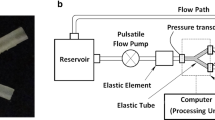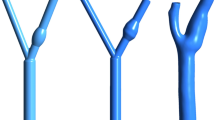Abstract
Carotid stenosis severity is a commonly used indicator for assessing risk of stroke. However, the majority of individuals with severe carotid artery disease never suffer a stroke, and strokes can occur even with only mild or moderate stenosis. This suggests local factors (other than stenosis severity) at or near the carotid artery bifurcation may be important in determining stroke risk. In this paper we investigate the effect of stenosis geometry on flow patterns in the stenosed carotid bifurcation, using concentrically and eccentrically stenosed anthropomorphic carotid bifurcation models having identical stenosis severity. Computational simulations and experimental flow visualizations both demonstrate marked differences in flow patterns of concentric and eccentric stenosis models for moderately and severely stenosed cases, respectively. In particular, we identify post-stenotic recirculation zone size and location, and spatial extent of elevated wall shear stress as key factors differing between the two geometries. As these are also key biophysical factors promoting thrombogenesis, we propose that the stenosed carotid bifurcation geometry—or the induced flow patterns themselves—may provide more specific indicators for those plaques that are vulnerable to enhanced thromboembolic potential, and hence, increased risk of ischemic stroke. © 2000 Biomedical Engineering Society.
PAC00: 8719Uv, 8710+e, 8719Xx
Similar content being viewed by others
REFERENCES
1_ Cahouet, J.and J. P. Chabard. Some fast 3D finite element solvers for the generalized Stokes problem. Int. J. Numer. Methods Fluids8:869-895, 1988.
2_ Denny-Brown, D.The treatment of recurrent cerebrovascular symptoms and the question of “vasospasm. ”Med. Clin. North Am.35:1457-1474, 1951.
3_ Ethier, C. R., S. Prakash, D. A. Steinman, R. Leask, G. Couch, and M. Ojha. Steady flow separation patterns in a 45 degree junction. J. Fluid Mech. (in press).
4_European Carotid Surgery Trialists’ (ECST) Collaborative Group.MRC European Carotid Surgery Trial: Interim results for symptomatic patients with severe (70%–99%) or with mild (0%–29%) carotid stenosis. Lancet337:1235-1243, 1991.
5_European Carotid Surgery Trialists’ (ECST) Collaborative Group.Risk of stroke in the distribution of an asymptomatic carotid artery. Lancet345:209-212, 1995.
6_European Carotid Surgery Trialists’ (ECST) Collaborative Group.Endarterectomy for moderate symptomatic carotid stenosis: Interim results from the MRC European Carotid Surgery Trial. Lancet347:1591-1593, 1996.
7_ Fabris, F., M. Zanocchi, M. Bo, G. Fonte, L. Poli, I. Bergoglio, E. Ferrario, and L. Pernigotti. Carotid plaque, aging, and risk factors. A study of 457 subjects. Stroke25:1133-1140, 1994.
8_ Fei, D. Y., C. Billian, and S. E. Rittgers. Flow dynamics in a stenosed carotid bifurcation model—Part I: Basic velocity measurements. Ultrasound Med. Biol.14:21-31, 1988.
9_ Fox, A. J.How to measure carotid stenosis. Radiology186:316-318, 1993.
10_ Gijsen, F. J., D. E. Palmen, van der Beek MH, van de Vosse FN, D. M. van, and J. D. Janssen. Analysis of the axial flow field in stenosed carotid artery bifurcation models—LDA experiments. J. Biomech.29:1483-1489, 1996.
11_ Hademenos, G. J.The biophysics of stroke. Am. Sci.85:226-235, 1997.
12_ Hellums, J. D.1993 Whitaker Lecture: Biorheology in thrombosis research. Ann. Biomed. Eng.22:445-455, 1994.
13_ Holdsworth, D. W., C. J. D. Norley, R. Frayne, D. A. Steinman, and B. K. Rutt. Characterization of common carotid blood-flow waveforms in normal subjects. Physiol. Meas.20:219-240, 1999.
14_ Ku, D. N.and D. P. Giddens. Laser Doppler anemometer measurements of pulsatile flow in a model carotid bifurcation. J. Biomech.20:407-421, 1987.
15_ Ku, D. N., D. P. Giddens, C. K. Zarins, and S. Glagov. Pulsatile flow and atherosclerosis in the human carotid bifurcation. Positive correlation between plaque location and low oscillating shear stress. Arteriosclerosis (Dallas)5:293-302, 1985.
16_ LoGerfo, F. W., M. D. Nowak, W. C. Quist, H. M. Crawshaw, and B. K. Bharadvaj. Flow studies in a model carotid bifurcation. Arteriosclerosis (Dallas)1:235-241, 1981.
17_ Loree, H. M., R. D. Kamm, C. M. Atkinson, and R. T. Lee. Turbulent pressure fluctuations on surface of model vascular stenoses. Am. J. Physiol.261:H644-H650, 1991.
18_ Maday, Y., A. T. Patera, and E. M. Ronquist. An operator-integration-factor splitting method for time-dependent problems: application to incompressible fluid flow. J. Sci. Comput.5:263-292, 1990.
19_ Milner, J. S., J. A. Moore, C. R. Ethier, B. K. Rutt, and D. A. Steinman. Computed hemodynamics of normal human carotid artery bifurcations derived from magnetic resonance imaging. J. Vasc. Surg.28:143-156, 1998.
20_North American Symptomatic Carotid Endarterectomy Trial (NASCET) Collaborators.Beneficial effect of carotid endarterectomy in symptomatic patients with high-grade carotid stenosis. N. Engl. J. Med.325:445-453, 1991.
21_North American Symptomatic Carotid Endarterectomy Trial (NASCET) Investigators. Clinical alert: Benefit of carotid endarterectomy for patients with high-grade stenosis of the internal carotid artery. Stroke22: 816-817, 1991.
22_ Palmen, D. E., F. N. van de Vosse, J. D. Janssen, and M. E. van Dongen. Analysis of the flow in stenosed carotid artery bifurcation models—hydrogen-bubble visualization. J. Biomech.27:581-590, 1994.
23_ Smith, R. F., B. K. Rutt, A. J. Fox, R. N. Rankin, and D. W. Holdsworth. Geometric characterization of stenosed human carotid arteries. Acad. Radiol.3:898-911, 1996.
24_ Smith, R. F., B. K. Rutt, and D. W. Holdsworth. Anthropomorphic carotid bifurcation phantom for MRI applications. J. Magn. Reson. Imaging10:533-544, 1999.
25_ Steinman, D. A.Simulated pathline visualization of computed periodic blood flow patterns. J. Biomech.33:623-628, 2000.
26_ Tousoulis, D., G. Davies, T. Crake, D. C. Lefroy, S. Rosen, and A. Maseri. Angiographic characteristics of infarct-related and non-infarct-related stenoses in patients in whom stable angina progressed to acute myocardial infarction. Am. Heart J.136:382-388, 1998.
27_ van Everdingen, K. J., C. J. Klijn, L. J. Kappelle, W. P. Mali, and J. van der Grond. MRA flow quantification in patients with a symptomatic internal carotid artery occlusion. The Dutch EC-IC Bypass Study Group. Stroke28:1595-1600, 1997.
28_ van Steenhoven, A. A., F. N. van de Vosse, C. C. Rindt, J. D. Janssen, and R. S. Reneman. Experimental and numerical analysis of carotid artery blood flow. Monogr. Atheroscler.15:250-260, 1990.
29_ Wurzinger, L. J., R. Optiz, P. Blasberg, and H. Schmid-Schonbein. Platelet and coagulation parameters following millisecond exposure to laminar shear stress. Thromb. Haemostasis54:381-386, 1985.
30_ Young, D. F.and F. Y. Tsai. Flow characteristics in models of arterial stenoses. I. Steady flow. J. Biomech.6:395-410, 1973.
31_ Zarins, C. K., D. P. Giddens, B. K. Bharadvaj, V. S. Sottiurai, R. F. Mabon, and S. Glagov. Carotid bifurcation atherosclerosis. Quantitative correlation of plaque localization with flow velocity profiles and wall shear stress. Circ. Res.53:502-514, 1983.
Author information
Authors and Affiliations
Rights and permissions
About this article
Cite this article
Steinman, D.A., Poepping, T.L., Tambasco, M. et al. Flow Patterns at the Stenosed Carotid Bifurcation: Effect of Concentric versus Eccentric Stenosis. Annals of Biomedical Engineering 28, 415–423 (2000). https://doi.org/10.1114/1.279
Issue Date:
DOI: https://doi.org/10.1114/1.279




